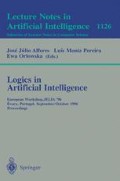Abstract
We present a modification of the unification algorithm which is adapted to the extraction of simultaneously unifiable literals from discrimination trees. The algorithm is useful for efficient implementation of binary resolution, hyperresolution, and paramodulation. The algorithm is able to traverse simultaneously more than one discrimination tree and to construct a unifier at the same time. In this way backtracking can be minimized.
Preview
Unable to display preview. Download preview PDF.
References
C-L. Chang, R. C-T. Lee, Symbolic Logic and Mechanical Theorem Proving, Academic Press, New York, 1973.
J. Christian, Flatterms, Discrimination Nets, and Fast Term Rewriting, Journal of Automated Reasoning 10, pp. 95–113, 1993.
P. Graf, Extended Path-Indexing, CADE 12, Ed. Alan Bundy, pp. 514–528, 1994.
W.H. Joyner, Resolution Strategies as Decision Procedures, J. ACM 23 (1), pp. 398–417, 1976.
R. Kowalski, P.J. Hayes, Semantic Trees in Automated Theorem Proving, Machine Intelligence 4, ed. B. Meltzer and D. Michie, 1969.
D. W. Loveland, Automated Theorem Proving, A Logical Basis, North Holland Publishing Company, Amsterdam, New York, Oxford, 1978.
W. McCune, Experiments with Discrimination-Tree Indexing and Path Indexing for Term Retrieval, Journal of Automated Reasoning, Vol. 9, pp. 147–167, 1992.
W. McCune, OTTER 3.0 Reference Manual and Guide + source, obtainable from info.mcs.anl.gov, 1994.
H. de Nivelle, Resolution Games and Non-Liftable Resolution Orderings, In CSL'94, pp. 279–293, Springer Verlag, 1994.
J. A. Robinson, A Machine Oriented Logic Based on the Resolution Principle, Journal of the ACM, Vol. 12, pp. 23–41, 1965.
J. A. Robinson, Automated Deduction with Hyperresolution, International Journal of Computer Mathematics 1, pp. 227–234, 1965.
M. Stickel, The Path-Indexing Method for Indexing Terms, Technical Note 473, Artificial Intelligence Center SRI International, Menlo Park CA, 1989.
L. Wos, A Note on McCune's Article on Discrimination Trees, Journal of Automated Reasoning 9, pp. 145–146, 1992.
N.K. Zamov: On a Bound for the Complexity of Terms in the Resolution Method, Trudy Mat. Inst. Steklov 128, pp. 5–13, 1972.
Author information
Authors and Affiliations
Editor information
Rights and permissions
Copyright information
© 1996 Springer-Verlag Berlin Heidelberg
About this paper
Cite this paper
de Nivelle, H. (1996). An algorithm for the retrieval of unifiers from discrimination trees. In: Alferes, J.J., Pereira, L.M., Orlowska, E. (eds) Logics in Artificial Intelligence. JELIA 1996. Lecture Notes in Computer Science, vol 1126. Springer, Berlin, Heidelberg. https://doi.org/10.1007/3-540-61630-6_2
Download citation
DOI: https://doi.org/10.1007/3-540-61630-6_2
Published:
Publisher Name: Springer, Berlin, Heidelberg
Print ISBN: 978-3-540-61630-6
Online ISBN: 978-3-540-70643-4
eBook Packages: Springer Book Archive

